nForce2 6-way Motherboard Roundup - December 2002
by Evan Lieb on December 4, 2002 6:53 PM EST- Posted in
- Motherboards
Chaintech 7NJS: BIOS and Overclocking
Chaintech chose Phoenix Technology's Award BIOS for their nForce2-based 7NJS motherboard. This is the BIOS of choice for nForce2 motherboards so far.

The PC Health section lists a good amount of readings. Here you'll find readings on CPU Vcore, PSU readings (all rails), VDIMM, VAGP, battery voltage, system and CPU temperatures and CPU and system fan speeds. There's also an option for adjusting Shutdown Temperature, which can read as high as 100 C if you want.
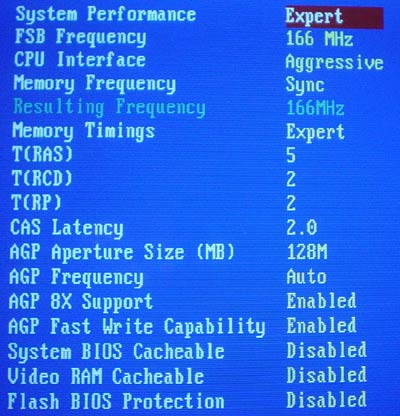
The Advanced Chipset Features includes the standard nForce2 options and adjustments. In this section you'll find adjustments for the CPU Interface, CPU multiplier, memory dividers, and various memory timings (including Active to Precharge, Precharge to Active, Active to CMD, and CAS latency). Precharge to Active and Active to CMD timings are adjustable from 1-7T and Active to Precharge is adjustable between 1T and 15T. The Active to Precharge timing ends up being the only setting of the bunch to take advantage of the very flexible DRAM timing options.
Another option found in the Advanced Chipset Features section is FSB adjustments. The FSB adjustments go as high as 200MHz. The 200MHz FSB limit in the BIOS isn't a big deal when you consider that we weren't able to reliably operate at 200MHz FSB anyway (even with a low CPU multiplier), as you'll see in our overclocking tests shortly.
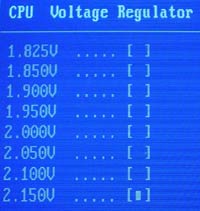
We were very impressed with the available voltage tweaking control in the 7NJS BIOS. For example, Vcore is adjustable all the way up to 2.15V in .025V increments, almost as much as the Epox 8RDA+'s Vcore ceiling. This Vcore should be more than enough for even the most extreme overclockers, and that includes HSF and water cooling overclockers. Thoroughbred-B users should have no issue with a max of 2.15Vcore, as default Thoroughbred-B Vcore is 1.65V. Despite what the 2.15Vcore option might insinuate, you'll "only" get as high as 2.11V if you decide to overvolt that high (which we strongly advise against), as default Thoroughbred-B Vcore fluctuated between 1.60V and 1.61V at idle according to the PC Health readings in the BIOS.
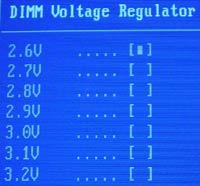
Another very impressive voltage tuning option in the 7NJS BIOS was VDIMM. VDIMM is adjustable all the way up to 3.2V in .01V increments, which is more than even Epox's 8RDA+, which managed no higher than 2.9V (2.92-2.93V actual) in it's BIOS. As read through PC Health, VDIMM fluctuates between 2.53-2.54V when VDIMM is set to 2.6V. Therefore, you'll "only" get 3.13-3.14VDIMM if you decide to overvolt that high. Again, you really don't' need to overvolt much to get a decent memory overclock, so we'd say it's pretty useless to run your memory over 2.8V unless you only plan on using your memory for a short period of time. We'd suggest 2.6V or 2.7V at the most.
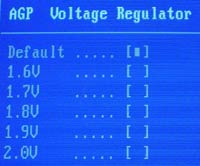
VAGP was yet another voltage that was highly tweakable in the 7NJS BIOS. AGP voltage is adjustable in .1V increments all the way up to 2.0V. Running your AGP at 2.0V is an extremely high voltage for you to be running at, and we strongly suggest against it. Still, it's nice to have for some video card overclockers, even despite the fact that VAPG tweaking doesn't usually aid video overclockers that much.
Even though there's definitely an AGP lock in the 7NJS BIOS, there isn't any visible PCI lock. According to Chaintech though, the 7NJS does indeed lock the PCI bus at 33MHz, there just isn't an option in the BIOS to tinker with it. We have no way of independently verifying this ourselves, so take it for what it's worth.
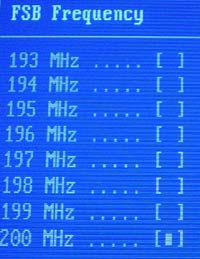
The Chaintech 7NJS ended up being one of the best FSB overclockers of the bunch, just a tad bit behind the Epox 8RDA+. Here were our FSB overclocking results using the following setup:
|
Front Side Bus Overclocking Testbed |
|
|
Processor:
|
Athlon
XP 2400+
|
|
CPU
Vcore:
|
1.65V
|
|
Cooling:
|
AMD
Retail HSF & Thermal Pad
|
|
Power
Supply:
|
Enermax
300W
|
Using this run-of-the-mill overclocking setup, we were able to hit 190MHz FSB. Not to bad at all, and almost as good as probably the highest overclocking Socket A motherboard on the planet, the Epox 8K5A2+. Thankfully, Chaintech was able to get us their newest BIOS revision to us on time for this review, as the latest BIOS revision added the much needed multiplier adjustments it was lacking with the October 25th BIOS. Therefore, this makes the 7NJS yet another motherboard that is able to adjust the multiplier of a Thoroughbred-B processor without any physical modification whatsoever to the CPU.

These features are necessary to the avid overclocker, which is in part what makes the 7NJS an excellent enthusiast motherboard.










1 Comments
View All Comments
c627627 - Monday, July 21, 2003 - link
MSI contradicts your reviewhttp://www.anandtech.com/mb/showdoc.html?i=1759&am...
You say:
"12/04/02 UPDATE: MSI sends word that the K7N2-L indeed does not have a PCI bus lock at 33MHz."
To this day, that was used as ultimate proof that the original MSI nForce2 mobo does not have a PCI lock.
Today MSI Senior Moderators said:
"they are wrong,and who ever told them it did not from msi"
(!)
Source:
http://www.msi.com.tw/program/e_service/forum/thre...
Won't you please settle this for us.